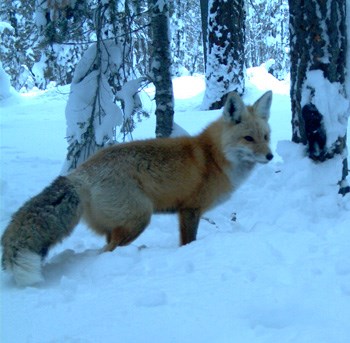
Jay Powers
As a subspecies of the red fox, the Sierra Nevada red fox is uniquely different from the familiar low-elevation fox that inhabits large areas of the earth and is familiar to humans and their folklore, cartoons, and literature. Not your average fox describes the alpine native that prefers the solitude of the wilderness, and life in the coldest Sierra terrain. The fact that Sierra Nevada red foxes eluded detection for over 100 years within Yosemite National Park is owing to their high-elevation and snow-covered habitat, extreme rarity, and avoidance of human contact.

Pete Figura Smaller in size than low-elevation red foxes, Sierra Nevada red foxes generally weigh 2 to 4 kg (4.5 to 9 lbs.), have a narrow pointed muzzle, large pointy ears, and a slender body and legs. They are typically yellowish to reddish brown, but, despite their name, can also be black or silver. Handsome dark-brown markings adorn the top of their ears and shins and white covers their chest and stomach. Their bushy fox tail always has a white tip, is long and flowing and carried close to the ground where it adds an additional dimension to their length. Because of the Sierra Nevada red foxes’ snowy and bitterly cold habitat, they have beneficial adaptations that serve them well as they survive winter in the Sierra. Their unusually thick and deep winter coat is particularly dense, adding warmth and insulation against wind, snow, and ice. Dense fur that covers their small toe pads serves the same purpose as a snowshoe, making for easy navigation over snow. At home in elevations above 6,000 feet, Sierra Nevada red foxes live amongst red fir, lodgepole pines, and alpine fell-fields. As members of the dog family, they are carnivores and prey upon mice, squirrels, hares, and gophers, but also eat manzanita berries. Opportunistic by temper, they forage in meadows, den in rock outcrops, dig and burrow in soil, and listen carefully in winter to detect rodent activity beneath the snow. Because the Sierra Nevada red fox was thought to have vanished from Yosemite National Park as well as the entire Sierra Nevada, park wildlife biologists are now implementing projects to gain vital information about the fox. Better understanding about their distribution and numbers is of greatest urgency especially as it relates to two possible threats to the fragile population: the effects of global warming on an animal that seemingly must have a high alpine habitat, and the possibility of non-native, lowland red foxes interbreeding and producing hybrids of reduced fitness. Yosemite National Park Wildlife Biologist Sarah Stock explained the interesting, scientific process underway: “Our Yosemite Conservancy project is surveying for Sierra Nevada red fox and collecting genetic information (though hair and scat) to gather baseline information about the population in Yosemite—how many are there, where are they, and how are they distributed. We’re collecting hair and scat for genetic analysis to help us understand the genetic diversity of the Sierra Nevada red fox population, but also to identify if nonnative red foxes co-occur in Yosemite and if they do, the extent of hybridization that has taken place.” The goal of the scientific studies on behalf of the Sierra Nevada red foxes is to give the animals the best chance for recovery. As a home-grown native to Yosemite National Park and the Sierra, perfectly suited to live in the rugged beauty of the wilderness, and as a species, the Sierra Nevada red fox is an important part of the natural heritage of all Californians. |
Last updated: December 3, 2018
